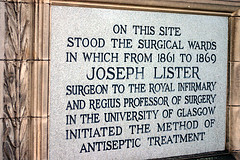|
|
|
August 11th, 2008 by Miki Saxon
 Awhile back I wrote several posts (rants?) on healthcare problems and some of the really terrible things that make my blood boil. Awhile back I wrote several posts (rants?) on healthcare problems and some of the really terrible things that make my blood boil.
Over the last couple of weeks several new article caught my eye and I wanted to bring them to your attention.
1. Following up a February post on doctors and medical researchers extensive conflicts of interest resulting from pharma industry funding and gifts.
Amazingly enough, two industry giants, Pfizer and Zimmer, which manufactures hip, knee, and elbow implants, are concerned about a potential conflict—although not about funding or gifts. This one is about ongoing physician education, often funded by industry players.
“At the center of this controversy are medical communications firms paid by pharmaceutical and device companies to produce physician-education courses. Critics say the manufacturers hire the marketing firms as intermediaries to help them influence doctors’ prescriptions and procedures.”
Gee maybe all the articles, investigations and general negative publicity coupled with a consumer revolt that might force action in Washington are having an effect.
2. It’s disgusting that financial institutions buy the debt of the un/under insured and then charge exorbitant interest rates on it.
Now the light is being shined on a practice that drives one more nail to the inability to buy insurance—assuming that you can even afford it.
“An untold number of people have been rejected for medical coverage for a reason they never could have guessed: Insurance companies are using huge, commercially available prescription databases to screen out applicants based on their drug purchases. … Most consumers and even many insurance agents are unaware that Humana, UnitedHealth Group, Aetna, Blue Cross plans, and other insurance giants have ready access to applicants’ prescription histories. These online reports, available in seconds from a pair of little-known intermediary companies at a cost of only about $15 per search, typically include voluminous information going back five years on dosage, refills, and possible medical conditions. The reports also provide a numerical score predicting what a person may cost an insurer in the future.”
3. We all know how important it is to wash our hands, but many of us are careless about doing it—including healthcare providers.
“Despite recommendations, nearly 60 percent of health-care workers do not wash hands while on duty. … Why? … For one thing, rigorous hand washing is time-consuming. Guidelines advise that we first rinse, then soap for 20 seconds, then rinse again for 30 seconds; after this, we paper-dry our hands and turn the faucet off using the paper towel. For health-care workers, the procedure is supposed to be followed before and after every patient encounter. That means two minutes per patient visit, which adds up to an hour for a doctor who sees an average 30 patients a day, and 2 1/2 hours per shift for an ICU nurse.”
Now, in an effort to force improvement, “Starting in October, hospitals will be penalized for the consequences of unwashed hands: Medicare will no longer pay for complications arising from certain hospital-acquired infections, which in many cases result from poor hand hygiene. This will be a powerful incentive for health executives to improve hand-washing compliance.”
Will it be an incentive? Or will the hospitals just bill the patient for what Medicare doesn’t cover and then sell the receivables to the highest bidder?
4. A possible bright spot—at least for those who work in large companies. It’s on-site medical clinics driven by the very best motivator—vested self-interest.
“[Toyota’s] medical center, which cost $9 million to build in 2007, could save the company many millions over the next decade. Managed by Take Care Health Systems whose business is running medical clinics, the program has helped Toyota slash big-ticket medical items including referrals to highly paid specialists, emergency room visits, and the use of costly brand-name drugs. Plus, there are big productivity gains because workers don’t have to leave the plant and drive to a doctor’s office for routine medical matters. … A recent study by benefits-consulting firm Watson Wyatt Worldwide found that 32% of all employers with more than 1,000 workers either have an on-site medical center or plan to build one by 2009. “We’re talking about a microcosm of health-care reform,” says Hal Rosenbluth, president of Walgreen’s health and wellness division. “Companies can take control and understand their health-care costs.””
In spite of a few bright spots, I honestly believe that the state of healthcare in the US is a mark of shame on the global stage.
What do you think?
Your comments—priceless
Don’t miss a po0nst, subscribe via RSS or EMAIL
Image credit: miqueias CC license
Posted in Ethics, Healthcare, Politics, What Do You Think? |
No Comments »
Sphere: Related Content
*/?>
April 5th, 2008 by Miki Saxon
Post from Leadership Turn Image credit: dimshikSorry, I forgot to mention this in the previous post.
I’ve recorded a lot of shows over the years and when I want some company for what I’m doing I pop one in my VCR.
 I was watching one recently and realized that there wasn’t even one drug commercial during the entire two hours. It was great. I was watching one recently and realized that there wasn’t even one drug commercial during the entire two hours. It was great.
These days, drug companies spend more than $6 billion a year on direct-to-consumer (DTC) advertising.
I prefer the thrilling days of yesteryear when there was a ban on DTC drug ads, but alas, Congress ditched it.
However, DTC is a real bone of contention for the FDA.
What do you think about drug advertising?
Your comments—priceless
Don’t miss a post, subscribe via RSS or EMAIL
Posted in Ethics, Healthcare, Politics, What Do You Think? |
No Comments »
Sphere: Related Content
*/?>
April 5th, 2008 by Miki Saxon
Post from Leadership Turn Image credit: arte_ram
As most of you know I’ve been writing a series on healthcare, linking to articles detailing the actions of doctors/healthcare professionals, insurance companies and financial institutions. What’s ahppening as opposed to political retoric of what should happen.
But last night I got to thinking.
The stuff the artilces describe isn’t new, it’s been going on for years. Sure, some are new wrinkles, but in general it’s all been around for quite a while.
Why suddenly all these articles? Why is the light being shown and the rocks turned over? What’s different?
Because it’s an election year? Unlikely, this stuff was going on four years ago, but there were no exposés about medical staff not washing their hands or drug companies financial involvement with doctors starting while they’re still in medical school.
So what’s new? What do you think has changed? What’s going on?
Your comments—priceless
Don’t miss a post, subscribe via RSS or EMAIL
Posted in Ethics, Healthcare, Politics, Thinking Out Loud, What Do You Think? |
No Comments »
Sphere: Related Content
*/?>
April 4th, 2008 by Miki Saxon
Post from Leadership Turn Image credit: Xurble
If it’s not doctors ripping off Medicare it’s disability insurers jacking up Social Security’s overhead in the name of increasing their profits.
 According to the New York Times, “The Social Security system is choking on paperwork and spending millions of dollars a year screening dubious applications for disability benefits, according to lawsuits filed by whistle-blowers…The insurers are forcing many people who file disability claims with them to also apply to Social Security — even people who clearly do not qualify for the government program.” According to the New York Times, “The Social Security system is choking on paperwork and spending millions of dollars a year screening dubious applications for disability benefits, according to lawsuits filed by whistle-blowers…The insurers are forcing many people who file disability claims with them to also apply to Social Security — even people who clearly do not qualify for the government program.”
The insurance companies use the simplest, tried-and-true approach around to ‘force’ the applications—threatening to or actually cutting off benefits.
How great is the cost?
“…it costs $1,180, on average, to process a single Social Security disability application to the first decision, usually a rejection. If the applicant persists through the first three levels — the initial review, a reconsideration and a hearing by an administrative law judge — the case will cost the system an average of $4,759″
Insurance companies refer 2.5 million disability applicants a year; considering just the basic processing cost that’s nearly three billion dollars. And since they insist on multiple appeals the cost is far higher. Plus, the extra load slows processing for the truly disabled.
Do the whistleblowers have a valid case? Seems likely since the expert witness for the plaintiffs is the former top administrator of the Social Security disability program Kenneth D. Nibali.
One way to stop this practice would be for Social Security to bill the insurance companies for processing costs on meritless claims.
A radical idea that would never get past the insurance lobby.
Think a bill-back would help? Have a better idea?
Your comments—priceless
Don’t miss a post, subscribe via RSS or EMAIL
Posted in Healthcare, Politics, What Leaders DON'T |
No Comments »
Sphere: Related Content
*/?>
March 28th, 2008 by Miki Saxon
Post from Leadership Turn Image credit: markhillary
(Part of an ongoing series)
 Those Americans fortunate enough to have medical insurance have long known (if they gave it any thought) that their sensitive medical records are frequently sent overseas for processing right along with most other forms of insurance processing. Those Americans fortunate enough to have medical insurance have long known (if they gave it any thought) that their sensitive medical records are frequently sent overseas for processing right along with most other forms of insurance processing.
Now their bodies are following—paid for by their own health insurance.
“David Boucher, 49, doesn’t fit the usual profile for such medical tourists. An assistant vice-president of health-care services at Blue Cross & Blue Shield of South Carolina, he has ample health benefits. But Boucher recently chose to have a colonoscopy at Bumrungrad International Hospital in Bangkok, mainly to make a point about the expanding options available to Blue Cross customers. And his company happily picked up the $640 tab—a bargain by U.S. standards.”
“”All of the largest U.S. insurers are starting to educate themselves or are putting [offshore] programs in place,” says Jonathan Edelheit, president of the Medical Tourism Assn., an industry group formed just last year. Companies that self-insure are also bombarding Edelheit’s group with requests for information.”
India’s not stupid, they know where the money is, as do many other countries and there are plenty of entrepreneurs who know that medical tourism is definitely a growth industry. One such is Value Medicare that offers “First world care at third world prices.”
The fact that most Indians don’t have access to medical tourism’s palatial care isn’t surprising either, in most countries locals can’t pay what foreigners pay and globally healthcare is a profit center.
One result from all this will be stronger financial returns for insurance companies—premiums based on actual US healthcare costs and payouts based on the price tags in countries with much lower costs—a heart bypass in the US costs $130,000, while it’s $18.5K in Singapore, $11K in Thailand and just $10K in India—all countries where the medical staffs are probably better at hand-washing, too.
Another will be more costs on the backs of the working poor and uninsured who have no options—unlike the poor in India where the state pays for the healthcare they do get.
Would you want to go overseas for a needed procedure?
Your comments—priceless
Don’t miss a post! Subscribe via RSS or EMAIL
Posted in Ethics, Healthcare, Politics, What Leaders DON'T |
No Comments »
Sphere: Related Content
*/?>
March 8th, 2008 by Miki Saxon
Healthcare providers’ attitudes towards money often make my blood boil. It’s not just insurance and drug companies and hospitals, but the financial institutions that buy the debt of the un/under insured and then charge exorbitant interest rates on it.
Of course, it’s all excused in the name of capitalism and keeping investors happy, while their advertising presents them as caring, do-the-right-thing organizations wrapped in concern for the well-being of their customers.
 Obviously it’s the former that ratifies their practice of charging for errors. Obviously it’s the former that ratifies their practice of charging for errors.
Hopefully it’s starting to change. “Since last fall, hospitals in 11 states have agreed to waive fees for certain rare errors dubbed “never events” because safety experts say they should never happen at all.”
But only 28 events make the grade—here are the top five.
- Surgery on the wrong body part.
- Surgery on the wrong patient.
- Wrong surgical procedure performed on a patient.
- Object left in patient after surgery.
- Death of patient who had been generally healthy during or immediately after surgery for a localized problem.
Discharging an infant to the wrong person is way down at number nine.
So what’s the cost?
“In 2006, Medicare was billed 764 times for objects left behind after surgery, resulting in an average payment of nearly $62,000 per event [$47,368,000]. The agency was billed 33 times for patients who got the wrong blood, at an average cost of $46,000 apiece [$1,518,000], and nearly 323,000 times for the worst kind of pressure ulcers, a preventable problem, at a cost of $40,381 [$13,043,063,000] apiece.”
Read the articles and make up your own mind.
If your blood boils send them to your State and Federal Congress people.
If it doesn’t I’d love to hear why not.
Your comments—priceless
Don’t miss a post, subscribe via RSS or EMAIL
Posted in Ethics, Healthcare, Politics, What Do You Think?, What Leaders DON'T |
2 Comments »
Sphere: Related Content
*/?>
March 7th, 2008 by Miki Saxon
 If you haven’t heard it already, here’s a story guaranteed to make you think at least twice before opting for any kind of avoidable surgery or hospital stay. If you haven’t heard it already, here’s a story guaranteed to make you think at least twice before opting for any kind of avoidable surgery or hospital stay.
“…hospital-acquired infections that kill nearly 100,000 people in the U.S. each year, according to federal estimates.”
That’s a very large number, especially when the top culprits are, “Doctors, nurses and other hospital staffers too busy, too distracted — or, sometimes, too arrogant — to wash [their hands].”
Can you even remember at what age your mom started the “wash your hands” ritual? Not to mention all the germ-killing products ads we’re inundated with daily.
How bad is it?
“At best, hospital staffers wash adequately about half the time…” Still worse, “some hospitals post hand hygiene rates as low as 20 percent when they start tracking the problem…”
While a 50% voter turnout is something to cheer, 50% adequate hand-washing, let alone 20%, is the stuff of nightmares.
And did you notice the qualifier ‘adequate’?
“National guidelines say they’re supposed to use alcohol-based hand rubs or soap and warm water for at least 15 seconds before and after every direct contact with a patient, with excretions, or with contaminated surfaces or objects,” moreover, that includes when they’re wearing gloves—strip the gloves and wash.
Of course, the information that washing reduces infections has only been around since 1846, so maybe it hasn’t had time to spread.
“…an August study in the journal Pediatrics that showed that boosting hygiene rates cut hospital-acquired infections by 60 percent in more than 1,000 tiny newborns at a children’s hospital in Switzerland,” and that was with a lousy 13% hand hygiene improvement!
According to Dr. Robert Wise, vice president of standards and survey methods for the Joint Commission, a national hospital accrediting agency, “there aren’t a lot of ways to measure compliance.”
Considering the rise of drug-resistant germs, such as MRSA (Methicillin-resistant Staphylococcus aureus), your best bet if you or someone you care about is hospitalized is to have someone who’s conscious available and always ask your provider to wash—be it your doctor, surgeon, a nurse or someone else.
Keep in mind that this applies just as much to doctor and dentist office visits, lab tests (I still remember ten years ago when I was in San Francisco and the tech refused to wear gloves when she went to draw my blood—needless to say I asked for and got another tech.) or any other setting.
Tomorrow I return to money—a healthcare subject near to all our hearts.
Have you had to ask someone to wash?
Would you?
Your comments—priceless
Don’t miss a post, subscribe via RSS or EMAIL
Posted in Ethics, Healthcare, Politics, What Leaders DON'T |
6 Comments »
Sphere: Related Content
*/?>
March 6th, 2008 by Miki Saxon
On the heels of Tuesday’s post I came to realize that every time I write about anything to do with healthcare I find more stuff that makes me want to scream and throw a tantrum. Rather than doing that (it upsets my cats and neighbors) I thought I’d let the steam off here.
I’ll start with a Forbes article (mentioned Monday on Project Management 411) focusing on the effect of corporate salespeople on healthcare costs. 
No surprise if you think of cause and effect—I sell you equipment and to justify the cost you push the service that it performs, which enables me to sell you a replacement version more quickly. Here’s the example Forbes gave.
“Radiologist David Gruen used to spend millions of dollars to replace his General Electric (it could just as well have been Siemens or Phillips) MRI and CT scanners every three years. It was money well spent because the machines were always busy…” but now he waits five years and the poor doctor had to take a 20% salary cut.
What happened?
“A year ago Medicare cut the price it pays for imaging, so Gruen gets paid 15% to 50% less for each order, depending on the type of scan. Health insurers got wise, too, and started imposing a 48-hour review on imaging orders. The doctor hired clerks to battle the HMOs, but his office volume was flat last year, down from 10% growth in prior years.“
Granted “Imaging accounts for only 5% of the $2 trillion in U.S. medical spending, but it has been the fastest-growing component of health care inflation in recent years, climbing 20% annually until last year,” but everybody wants one. Scanning businesses offer specials and run sales just as other consumer products do.
Of course, the drug companies are doing the same thing, “Today drugs are promoted in much the same way as other products. Drug companies devote forty percent of their advertising expenditures — over $4 billion per year — to DTC [direct-to-consumer] ads. The average American views as many as 16 hours of prescription drug ads per year…”
DTC ads are under Congressional review and has been framed as a free speech issue by the drug companies.
I understand that medical products and drugs are businesses and that as businesses they focus on profit in order to keep Wall Street happy—happy Wall Street = rising stock = happy investors—but at what cost to the future of this country?
Come back tomorrow for my take on the dirtiest little secret in medicine.
What are your views on DTC drug and medical procedure ads?
Your comments—priceless
Don’t miss a post, subscribe via RSS or EMAIL
Posted in About Leadership, Ethics, Healthcare, Leading Factors, Politics, What Do You Think? |
No Comments »
Sphere: Related Content
*/?>
February 16th, 2008 by Miki Saxon
The difficulty of getting an appointment to see your doctor (wait time) is the bogyman thrown up to defeat universal healthcare, but the statistics don’t back that up. According a Business Week article citing a study by the Commonwealth Fund,“If you find a suspicious-looking mole and want to see a dermatologist, you can expect an average wait of 38 days in the U.S., and up to 73 days if you live in Boston…a knee injury… the average time needed to see an orthopedic surgeon ranges from 8 days in Atlanta to 43 days in Los Angeles. Nationwide, the average is 17 days.”… only 40% of U.S. doctors have arrangements for after-hours care, vs. 75% in the rest of the industrialized world… 51% of sick Americans surveyed did not visit a doctor, get a needed test, or fill a prescription within the past two years because of cost. No other country came close.”
In the Washington Monthly Kevin Drum cites the BW article and also mentions that “…the numbers are inflated because we don’t count the people who can’t get nonemergency surgery [such as hip replacements] because they’re uninsured…,” while the comments left by readers put real stories to the statistics.
Not all physicians are against a universal health program, which is smart since many Americans of more modest means are traveling in order to off-shore their healthcare needs—surgical and otherwise.
“Gary Hulmes, a furniture store manager from Florida who went to New Delhi to have spinal surgery done and paid a total of $9,000 including airfare, a five-day hospital stay, and a total stay of three weeks in India (with some sightseeing thrown in). If performed in a US hospital, the same procedure would have cost $36,000 – 50,000.”
In Europe healthcare is measured, evaluated and reported publicly by Health Consumer Powerhouse Euro Health Consumer Index 2007.
The report makes for interesting reading.
“All the 27 EU members are of course included in this year’s index as well as Switzerland and Norway.”
‘The 2007 Index is, just like in 2006, built up as a “pentathlon”, with indicators grouped in five sub-disciplines. After having had to surrender to the “lack of statistics syndrome”, and after scrutiny by our expert panels, 27 indicators survived into the EHCI 2007.
The indicator areas for the EHCI 2007 thus became:
Sub-discipline Number of indicators
- Patient rights and information 9
- Waiting time for treatment 5
- Outcomes 5
- “Generosity” 4
- Pharmaceuticals 4″
Dr. David J. Brailer is point man on the Administration’s “…effort to remake the $1.9 trillion U.S. health-care business by using information technology to save money and lives…Paying for the network will be the first major hurdle. Many cash-strapped hospitals and small-practice doctors have no interest in footing the bill for a medical Internet. One key reason is the mismatch between costs and savings: While health-care providers bear the cost of tech investments, Medicare and private insurers reap almost all the savings.”
Then, of course, there are all those cute, educational consumer ads for drugs to help things along.
Of course, any discussion of healthcare wold be incomplete without some reference to the insurance industry. An industry, to my mind, far more committed to executive compensation and investor profits than service to its policy holders. Rather than add to the thousands of commentary already out there, I thought I’d leave you with a visual that, to me, says it all.
So what comes first?
Finding a way to pay for healthcare or knowing what we’re paying for?
Would the money being spent on pork and corporate subsidies be better spent on healthcare for all Americans?
If not, should the companies that currently pay no, or little, tax be the focus as opposed to small business?
What do you think should/can be done to fix this mess?
Your comments—priceless
Don’t miss a post, subscribe via RSS or EMAIL
Posted in About Leadership, Ethics, Healthcare, Leading Factors, Politics, What Do You Think? |
6 Comments »
Sphere: Related Content
*/?>
February 15th, 2008 by Miki Saxon
Matt Weeks has held various management positions in the financial services/banking industry, started, ran and sold a small business, ran a successful consulting practice and currently is CEO/founder of stealth mode startup eyeTmedia.
“The idea of some sort of assessment or tax on businesses to fund health care for those citizens who are otherwise not covered is a bad idea.
While I agree that ER room medicine is not smart preventative, wellness-based medicine and is not good social or fiscal policy, we have to find a different approach other than force-funding it on the back of business. And take note, it will primarily fall on small businesses.
Most of the businesses in our Great Country are “small businesses.” When I was at Intuit, makers of QuickBooks, Quicken and TurboTax, my team launched the Online Payroll Service. In the course of understanding what our customers wanted, we discovered that most of the “small business” enterprises were in fact sole proprietors, or very small companies with fewer than six employees, counting the owner(s).
Now let’s reconcile that fact (check with the SBA and DOL -Department Of Labor) with the other reality that most “workers” in The United States are employed at these small businesses. Not huge corporations. Thus the main “driver” of employment as well as productivity in the country are these small businesses.
One final step: If we believe the Fed, when they tell us that the driver of our economy is spending in the retail sector, then we must look directly to the bulk of the employees and their families for that spend, presumably coming from disposable income. So it is circular, as the small business employees spend their disposable income at other small businesses. Thus we still live in villages to a greater extent than we may believe.
However, small businesses have a devil’s bargain. If they are burdened with an additional expense in the form of a tax or assessment (like an extra payroll tax), they will have to lay off employees, or drastically reduce their pay, or their pay increases, absent some dramatic increase in productivity or other business growth. I cannot connect the dots between less cash in the company and dramatic growth. Less cash is not a driver of business health and expansion.
So the net effect of this well-intentioned but ill-thought-through idea will be less cash in the economy, lower net wages for employees, and questionable coverage, which is not mapped-out.
You might say that this will not impact these “small businesses” and that we’ll focus on the large businesses. The problem here is that those large businesses that do not already provide a reasonably sensible benefits package are, by definition, stingy and mean-spirited. They are unlikely to have some epiphany about “doing the right thing” and are more likely to just move offshore. As in moving all the jobs they can move offshore. Not a good thing either. That just leaves us with fewer employed people to pay for this whole idea.
So large companies who are bad actors are not likely to be the source of this cash (and will likely cut and run), and the bulk of employees in the country who work for small businesses are likely to be in even more pain if their companies are forced to make meaningful payments to some centrally managed health care superfund. And who among us believe that such a superfund will be efficient or effective?
So I say “yes” we need to approach the problem, and keep the value of covering the non-covered. I just suggest thinking it through a bit more. Many people think “business” is the big bad corporation. In fact, our economy is based on small businesses, and perhaps the only true ethical accountability for “doing the right thing” exists there, at the local, in-person level. Let’s dig a bit deeper and find a more effective approach.
It’s a hard problem. I don’t have answers… But I do know that a blanket “tax” or “assessment” on a monolithic “business” category is wrong-headed and overly simplistic given the complexity of the problem.”
Does the US really need to raise taxes to fund healthcare or is the money actually there, but being incorrectly spent via pork, earmarks, etc.?
Your comments—priceless
Don’t miss a post, subscribe via RSS or EMAIL
Posted in About Leadership, Healthcare, Leading Factors, Politics, What Do You Think? |
2 Comments »
Sphere: Related Content
*/?>
|
 Subscribe to
Subscribe to
MAPping Company Success
About Miki 
Clarify your exec summary, website, etc.
Have a quick question or just want to chat? Feel free to write or call me at 360.335.8054
The 12 Ingredients of a Fillable Req
CheatSheet for InterviewERS
CheatSheet for InterviewEEs™
Give your mind a rest. Here are 4 quick ways to get rid of kinks, break a logjam or juice your creativity!
Creative mousing
Bubblewrap!
Animal innovation
Brain teaser
The latest disaster is here at home; donate to the East Coast recovery efforts now!
Text REDCROSS to 90999 to make a $10 donation or call 00.733.2767. $10 really really does make a difference and you'll never miss it.
And always donate what you can whenever you can
The following accept cash and in-kind donations: Doctors Without Borders, UNICEF, Red Cross, World Food Program, Save the Children
*/
?>About Miki
About KG
Clarify your exec summary, website, marketing collateral, etc.
Have a question or just want to chat @ no cost? Feel free to write
Download useful assistance now.
Entrepreneurs face difficulties that are hard for most people to imagine, let alone understand. You can find anonymous help and connections that do understand at 7 cups of tea.
Crises never end.
$10 really does make a difference and you’ll never miss it,
while $10 a month has exponential power.
Always donate what you can whenever you can.
The following accept cash and in-kind donations:
|
 Awhile back I wrote several posts (rants?) on healthcare problems and some of the really terrible things that make my blood boil.
Awhile back I wrote several posts (rants?) on healthcare problems and some of the really terrible things that make my blood boil.



 I was watching one recently and realized that there wasn’t even one drug commercial during the entire two hours. It was great.
I was watching one recently and realized that there wasn’t even one drug commercial during the entire two hours. It was great.
 According to the
According to the 

 If you haven’t heard it already, here’s a
If you haven’t heard it already, here’s a 


